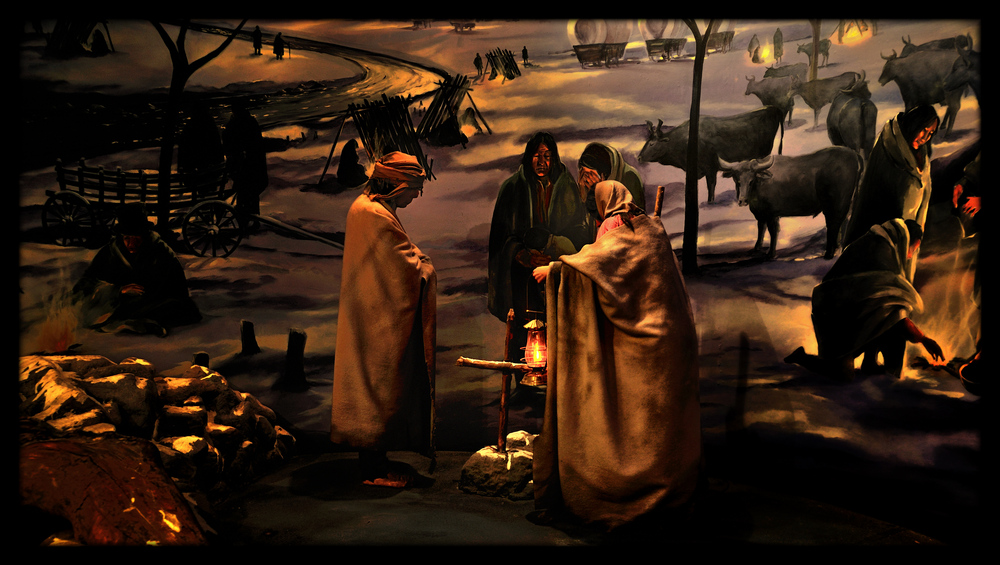Trail of Tears
Cherokee removal, also called the Trail of Tears, refers to the forced relocation between 1836 to 1839 of the Cherokee Nation from their lands in Georgia, Tennessee, Alabama, and North Carolina to the Indian Territory (present day Oklahoma) in the Western United States, which resulted in the deaths of approximately 4,000 Cherokees.
In the Cherokee language, the event is called Nu na da ul tsun yi (the place where they cried), another term is Tlo va sa (our removal). However, this phrase was not used by Cherokees at the time, and seems to be of Choctaw origin. The Cherokees were not the only American Indians to emigrate as a result of the Indian Removal efforts. American Indians were not only removed from the American South but also from the North, Midwest, Southwest, and Plains regions. The Choctaws, Chickasaws, and Creek Indians (Muskogee) emigrated reluctantly. The Seminoles in Florida resisted removal by guerrilla warfare with the United States Army for decades (1817–1850). Ultimately, some Seminoles remained in their Florida home country, while others were transported to Indian Territory in shackles. In contrast, the Cherokees resisted removal by hiring lawyers. They won their case before the U.S. Supreme Court (Worcester v. State of Georgia), but were forced to emigrate anyway.
The phrase, “Trail of Tears”, is used to refer to similar events endured by other Indian people, especially among the Five Civilized Tribes. The phrase originated as a description of the voluntary removal of the Choctaw nation in 1831.
In the fall of 1835, a census was taken by civilian officials of the US War Department to enumerate Cherokees residing in Alabama, Georgia, North Carolina, and Tennessee, with a count of 16,542 Cherokees, 201 inter-married whites, and 1592 slaves (total: 18,335 people). In October of that year Principal John Ross and an Eastern visitor, John Howard Payne were kidnapped from Ross' Tennessee home by a renegade group of the Georgia militia. Released, Ross and a delegation of tribal leaders travelled to Washington, DC to protest this high-handed action, and to lobby against the removal policy of President Andrew Jackson. In this power vacuum, U.S. Agent John F. Schermerhorn gathered a group of dissident Cherokees in the home of Elias Boudinot at the tribal capitol, New Echota, Georgia. There on December 29, 1835, this rump group signed the unauthorized Treaty of New Echota, which exchanged Cherokee land in the East for lands west of the Mississippi River in Indian Territory. This agreement was never accepted by the elected tribal leadership or a majority of the Cherokee people. In February, 1836 two Councils convened at Red Clay, Tennessee and at Valley Town, North Carolina (now Murphy, NC) and produced two lists totaling some 13,000 names written in the Sequoyah writing script of Cherokees opposed to the Treaty. The lists were dispatched to Washington, DC and presented by Chief Ross to Congress. Nevertheless, a slightly modified version of the Treaty, was ratified by the U.S. Senate by a single vote on May 23, 1836, and signed into law by President Andrew Jackson. The Treaty provided a grace period until May 1838 for the tribe to voluntarily remove themselves to Indian Territory.
source: http://en.wikipedia.org/wiki/Cherokee_trail_of_tears
From the Cherokee Museum, April 2010










Michael Grotkamp 11/05/2010 7:43
very good capured for a museum shot.lg, Michael
CsomorLászló 10/05/2010 19:34
Like this colors!lg
CsL